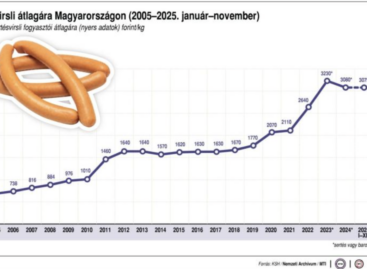Reshaped and flavored: what lies behind meat products?
Whether it’s hot dogs, Parisian sausages or dinosaur-shaped meat patties, reshaped meat products have been on store shelves for a long time. But whose interests does this practice serve – the producers’ or the consumers’? And are all additives really harmful?
 Reshaped meat products are products that are made from various meat parts, minced meat or by-products, and then shaped, pressed and heat-treated to obtain their final shape. These include cold cuts, sausages, sausages, pork cheeses, liverwurst, meat patties and even shaped hams. The advantage of the process is that it allows the utilization of less valuable or fattier meat parts and offal, thereby reducing food waste and lowering production costs.
Reshaped meat products are products that are made from various meat parts, minced meat or by-products, and then shaped, pressed and heat-treated to obtain their final shape. These include cold cuts, sausages, sausages, pork cheeses, liverwurst, meat patties and even shaped hams. The advantage of the process is that it allows the utilization of less valuable or fattier meat parts and offal, thereby reducing food waste and lowering production costs.
The advantages on the consumer side are also not negligible. Shaped products are easy to slice, portion and store – in other words, they are practical. This is a serious consideration in the context of modern lifestyles and fast-food eating habits. In addition, the spices and texture combinations used during the process also allow for a more diverse range of flavors. In some products, the shape itself is functional: for example, a hot dog is cylindrically shaped to fit into a hot dog bun, just as a meat patty must be made to a regular size for fast-food sandwiches.
The additives used in the production of products are often criticized, but most of them serve a well-defined technological purpose. Preservatives – such as nitrites – prevent microbiological spoilage and inhibit the growth of dangerous bacteria such as Clostridium botulinum. They also help preserve the characteristic reddish hue of the meat. Antioxidants, such as vitamin C (ascorbic acid), are also often used, which both improve the color and increase the shelf life of the product.
Firming agents – such as phosphates, carrageenans, starches – improve the structure, water-binding capacity and sliceability of the product. Their use ensures that the product is not dry, crumbly or suffers from water and fat separation. Water binding is not just the notorious example of “water-enriched” products: the appropriate moisture content is also crucial for the enjoyment value.
Controlling the pH value of meat products – for example with baking soda, citric acid or acetic acid – also improves the shelf life, as it prevents the growth of unwanted microorganisms. The purpose of seasonings and flavour enhancers – salt, pepper, paprika, spice mixtures, monosodium glutamate – is to enrich the flavour of the product. Although excessive use of flavour enhancers can lead to addiction, when used in moderation they also serve the consumer experience.
It is important to highlight that the use of additives is strictly controlled by the European Union and domestic food safety regulations. Only those substances whose safety is supported by scientific studies can be placed on the market, and only in the permitted amounts.
Reformulated products and additives are therefore not from the devil. While cost-effectiveness and product stability are the main considerations for manufacturers, from the consumer’s point of view, practicality, taste and shelf life are what matter. The key to a healthy balance is transparency: manufacturers must communicate honestly about their products, and consumers must make informed decisions – with information.
Reformulated meat products, even if they do not belong to the world of fine dining, are part of everyday nutrition. The point is not to reject them, but to know what is on our plate – and why.
Related news
Sausage prices before New Year’s Eve: cheap entry, expensive premium – how big is the gap on the shelves?
🎧 Hallgasd a cikket: Lejátszás Szünet Folytatás Leállítás Nyelv: Auto…
Read more >NAK: it’s worth buying Hungarian sausages on New Year’s Eve too
🎧 Hallgasd a cikket: Lejátszás Szünet Folytatás Leállítás Nyelv: Auto…
Read more >The kings of the New Year’s Eve list: hot dogs and champagne in abundance
🎧 Hallgasd a cikket: Lejátszás Szünet Folytatás Leállítás Nyelv: Auto…
Read more >Related news
The 6 most important payment trends in 2026:
🎧 Hallgasd a cikket: Lejátszás Szünet Folytatás Leállítás Nyelv: Auto…
Read more >Tourism continues to expand dynamically
🎧 Hallgasd a cikket: Lejátszás Szünet Folytatás Leállítás Nyelv: Auto…
Read more >FEOSZ creates a certificate for consumer-friendly web stores
🎧 Hallgasd a cikket: Lejátszás Szünet Folytatás Leállítás Nyelv: Auto…
Read more >







